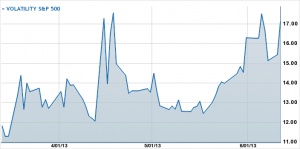Volatility is back in a big way. It’s back not only in the stock market, but in the bond market. It’s back not only in the U.S., but in China, Japan and other countries. It’s back not only in developed countries, but in emerging markets.
Just a few signs that volatility has returned:
- The Dow Jones Industrial Average (DJIA) has had intraday swings of more than 100 points in 10 straight sessions. On five of those days, the market finished up; on five, it finished down.
- The Chicago Board Options Exchange Volatility Index (VIX) has jumped more than 40% since May 17.
- Trading in VIX futures set records for each of the first four months of the year. May was the third most active trading month ever.
- The yield on 10-year U.S. Treasuries hit a 14-month high of 2.27% during Tuesday’s trading.
The VIX, also known as the “fear gauge,” jumped from a low of 12.26 on May 17 to 17.25 on Tuesday, but it is still at a relatively low level. In 2011, it was regularly over 30 and in 2008, it rose over 80.
But it’s clearly on its way up, as the chart shows.
The volatility began when Federal Reserve Board Chairman Ben Bernanke hinted that The Fed may ease back on its bond buying. He never said that quantitative easing would end – it was more like tapping the brake to slow down – and he linked and Fed action to continued economic improvement.
Yet it was still enough to trigger an increase in volatility. Continuing market swings will likely follow, barring additional Fed action to calm the markets.
Investing for Volatility
Of course, markets do not go in one direction forever. When volatility arrives, investors need to be ready for it.
Diversification can serve as a shock absorber, smoothing a bumpy ride, but when volatility is widespread, diversification is less effective.
Volatility also creates buying opportunities when the market drops, but no one can say for certain when the market is at a low point and is about to swing back up.
Investors can also invest in exchange-traded funds (ETFs) that are tied to the VIX. ProShares offers the short-term VIX (VIXY) and the intermediate term VIX (VIXM), but they are difficult to trade and have fared poorly over the past year, because volatility has been low.
Investors have to own the VIX to take advantage of increasing volatility, but they have to be prepared to sit through some pain if the market continues to grind higher. However, if volatility is indeed back, the VIX can easily move 100% and the ProShares ETFs will move along with it.

